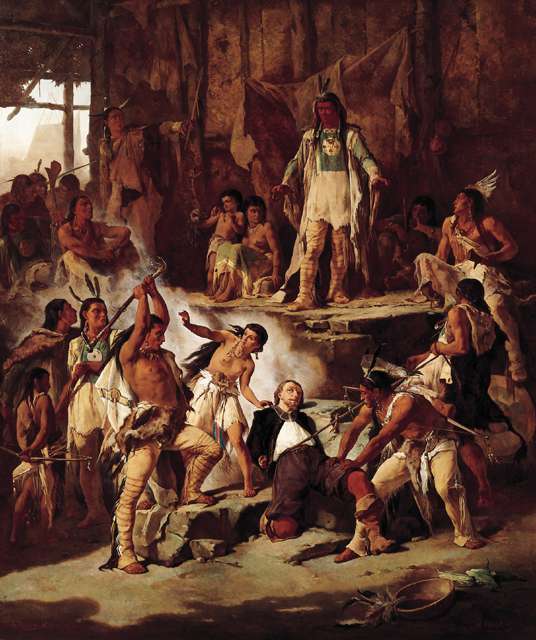Western artists interpreted Native American culture repeatedly from a variety of perspectives over the course of American history. Look at Victor Nehlig’s late-nineteenth-century depiction of the classic story of Pocahontas and John Smith. Does this painting seem to perpetuate any pre-conceived notions held by Europeans with respect to Native American culture? Unlike Nehlig, Eanger Irving Couse who painted The Lovers and Maynard Dixon who painted Hopi Man both observed Native American culture first-hand while living among these populations. How do their artworks reflect this different relationship between the artist and subject? How do later works by Native American artists such as Marie Watt’s Blanket Stories: Ancestor, Baron Woolen Mill, and Hill People present the traditions of their own culture?
Victor Nehlig (1830–1909) Pocahontas and John Smith
Gift of Dixon Limited (Dean Larson)

Maynard Dixon (1875–1946) Hopi Man
Gift of Herald R. Clark

Eanger Irving Couse (1866–1936) The Lovers
Gift of Janet Southwick

Marie Watt (b. 1967) Blanket Stories: Ancestor, Baron Woolen Mill, and Hill People
Purchased with funds provided by Curtis Atkisson; and David and Bianca Lisonbee in memory of Rita Palmieri Elkin

YOU MAY NOTICE
Victor Nehlig was a Frenchman who later moved to America and lived out the remainder of his life here. Many Europeans were fascinated by the New World tales of cowboys and Indians in the “wild West.” Pocahontas and John Smith reflects the limited knowledge of correct Native American clothing and customs frequently perpetuated throughout art and literature.
At the turn of the twentieth century, there was a widespread fervor in the United States for collecting Native American art, which by then was widely available in department stores and elsewhere across the country. Wealthy collectors created “Indian corners” in their homes to flaunt their purchases. Couse’s The Lovers and Maynard Dixon’s Hopi Man could have been included in such displays; however, the artists’ residency among the subjects they painted seems to add an authenticity not present in Nehlig’s depiction.
Marie Watt’s Blanket Stories: Ancestor, Baron Woolen Mill, and Hill People accentuates the importance of textiles in the lives of Native American cultures. Blankets, which have often appeared in visual representations of Native Americans by artists of European descent, are now being used by indigenous artists to tell the story of their own cultural heritage.